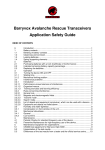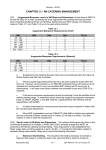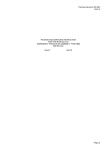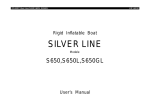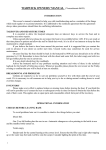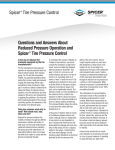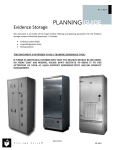Download User manual
Transcript
EASINESS User manual Edition 2 / 11_2012 Edition 2 / 11_2012 Contents Thank you for flying ADVANCE ....................................................... 4 About ADVANCE .............................................................................. 5 The EASINESS.................................................................................. 6 Welcome on board!....................................................................... 6 Special features of the EASINESS................................................ 6 Safety advice.................................................................................... 7 General advice about paragliding................................................ 7 Preparing the product for use.......................................................... 8 Delivery......................................................................................... 8 Delivery package.......................................................................... 8 Adjusting the harness................................................................... 8 Fitting the speedbar.................................................................... 10 Installing a reserve in the front container.................................... 10 Fitting the protector..................................................................... 14 Adjusting the rucksack................................................................ 14 Using the EASINESS...................................................................... 16 Packing the rucksack.................................................................. 16 Packing the back pocket for flight ............................................. 16 Reserve suspension ................................................................... 16 Throwing the reserve....................................................................17 Use in school ...............................................................................17 Use with other makes of paraglider.............................................17 Winching ......................................................................................17 Acro flying .................................................................................. 18 Tandem flying.............................................................................. 18 Before takeoff.............................................................................. 18 Maintenance, repairs and care ...................................................... 19 Care and maintenance ............................................................... 19 Check ......................................................................................... 20 Repairs ....................................................................................... 20 Disposal ..................................................................................... 20 Technical details............................................................................. 22 Technical Data............................................................................. 22 Material used............................................................................... 23 Certification................................................................................. 23 Service............................................................................................ 24 ADVANCE Service Centres......................................................... 24 ADVANCE website ..................................................................... 24 Warranty...................................................................................... 24 Parts................................................................................................ 26 Harness....................................................................................... 26 Rucksack..................................................................................... 27 Annex.............................................................................................. 28 3 Thank you for flying ADVANCE Congratulations on your choice of an EASINESS - a quality product from ADVANCE. We are confident that you will spend many rewarding hours in the air with it. This manual contains instructions and important advice about safety, care and maintenance. We strongly advise that you read it carefully before your first flight with the harness. You can always find the latest version of the manual and additional up-to-date information on www.advance.ch. Any new safety-related findings about the product will be published there. For questions or problems please contact your supplier or ADVANCE direct. We wish you a lot of fun with the EASINESS and, as always, “happy landings”. Team ADVANCE 4 About ADVANCE ADVANCE is one of the leading worldwide paraglider manufacturers, and is based in Switzerland. Since the company was founded in 1988 it has maintained its own policies and concepts, both in development and production. The results are matured products with unmistakable characteristics. Backing the brand is a team of experts who share the passion of those who put their trust in ADVANCE products. With their own understanding of flight they bring their personal experience and dedication to the working processes. Total control of the production process and close supervision of the working practices in the dedicated factory in Vietnam guarantee a high standard of workmanship. A long term relationship with fabric and line manufacturers also enables ADVANCE knowledge and expertise to find its way directly into the development of new materials. ADVANCE puts great importance on after-sales customer support, and has built up a worldwide service network for this purpose. An on-going interaction with customers brings new insights that find their way into ADVANCE products – thus completing the «Circle of Service». 5 The EASINESS Welcome on board! EASINESS is an extremely light and very comfortable reversible harness. The no-seatboard, one-size-fits-all harness weighs 1.3 kg and is best suited to Hike & Fly pilots, leisure flyers, travellers and vol bivouackers . Special features of the EASINESS • Easy handling • Uncompromisingly light and sophisticated in design • The most from the least (minimum build, big result) This reversible harness, with carabiners, weighs in at around 1.3 kgs as a result of high quality light materials and a strikingly simple concept: an optional protector weighs another 270 gm. • Clothing can be stuffed in the bungee chords on the back pocket. • There’s an opening for a Camelbak tube and a fixing loop on a shoulder strap. • A special helmet holder on top leaves more room inside the ruck- sack. • Ergonomically shaped back support and breathable double-mesh material on the shoulder straps for cool carrying. • Hand/wrist loops on the shoulder straps for relaxed hiking. • Stowable holding loops on the side of the rucksack for carrying mountain gear – (snowshoes, crampons, ice axe, etc.). • Wide hip strap for perfect stability and good walking comfort. • Loads of extra little packing places. • The speed system has roller bearings and is nice to use. • One size fits all: suits pilots from 155 cm to 190 cm tall. • This light harness has the ADVANCE look: elegant, simple, classy. More important details • The harness has the well-tried-and-tested, two-slide-buckle ADVANCE combined chest-with-leg-straps closure system (called Safe-T-System). • A normal sized round reserve can be carried in the adjustable capacity front container. 6 Safety advice As with all commercial reserve parachutes paraglider harnesses, because of their design, are not at all suitable for freefall parachuting. The reserve and its attachments are not designed for an abrupt opening. All adjustments to the harness should definitely be made before flight. Correct harness settings contribute decisively to functioning, safety and comfort in flight. items of equipment should be checked for damage and airworthiness. A proper pre-takeoff check must also be carried out. When carrying out paraglider sports every pilot bears sole responsibility for all risks including injury and death. Neither the manufacturer nor the seller of a paraglider can guarantee or be held responsible for the pilot’s safety. The EASINESS is only to be used for paragliding. General advice about paragliding Flying a paraglider calls for appropriate training and a sound knowledge of the subject, as well as, of course, the necessary insurance cover and licence. A pilot must be able to correctly assess the weather conditions before taking off. His or her capabilities must be adequate for the actual paraglider. The paraglider pilot is also required bear a sense of responsibility towards the natural world, especially regarding the preservation of wildlife and landscape. Wearing an adequate helmet, suitable boots and clothing, and carrying an emergency parachute are essential. Before every flight all 7 Preparing the product for use Delivery Adjusting the harness Before delivery every ADVANCE product has to be checked by the dealer for completeness and correct basic settings. The completed warranty document will ensure that defects in the product attributable to manufacturing faults are covered by the ADVANCE warranty. (See Warranty in the section «Service».) The EASINESS is simple to adjust because, to a great extent, it adapts itself to fit the pilot’s body. Delivery package All the EASINESS settings can be adjusted in the air as well as on the ground. ADVANCE recommend that you check out the settings carefully before you fly. In any case the first test flight should take place in quiet conditions. The EASINESS harness package contains: • Reversible harness • 2 riser quicklinks (as carabiners) • ‘EASINESS Getting Started’ booklet • 3 reserve connection straps (attached to the shoulder straps) Tip: Pack the back pocket and install the reserve before you start adjusting. This will give something close to a realistic fly- ing attitude. Options for the EASINESS are: • an adjustable size front container with reserve handle and a reserve Y-connection • a 270g lightweight, LTF approved airbag protector All adjusters are completely open at delivery. 1. Start at the basic settings To save weight the leg straps 1 are not adjustable. Carabiner distance is variable. Advance recommend that you fly with a carabiner distance of 40 to 42 cm. 8 2. Setting the upper body angle Now you can alter your upper body recline angle using the back straps 2 . The back straps at the sides are mounted relatively high. This gives good back support and takes weight off the shoulders. Finally you can tighten or loosen the shoulder straps as you wish – quite loose, or providing light support – but without putting pressure on the shoulders. 2 1 1 3. Setting the distance between the leg rests Finally you can set the distance between the two leg rests; when shortened this makes the EASINESS feel compact and more stable in flight 3 . 3 4. Checking the settings Recheck that the shoulder straps give only light support. 9 2 Fitting the speedbar Lead the speed lines through the D rings 1 under the leg rests. Then pull them through the pulleys and the hole in the elastic cover 2 , then connect them with the glider. Caution: The speed system is correctly set up when you can use the whole accelerate range of the glider. Make absolutely sure that the speed lines are not adjusted too short, so that the glider would be always accelerated in flight. Installing a reserve in the front container General advice Every reserve/harness combination has its own characteristics. It is essential that pilot and parachute packer are familiar with the system to make sure it works reliably. 1 The adjustable size front container has room for round reserves of volumes from approximately 3 to 6 litres. Instructions for connecting the reserve with the harness and fitting it in the supplied front container follow. We strongly recommend that you go to a qualified person or your dealer to do this to ensure correct installation. 10 Info: The volume formula can be used as a very rough approximation (Reserve weight in kilos x 2.7 = Volume in litres). Even so, depending on packing style and quality, a re- serve so calculated to be within the maximum volume limit may not release properly. Caution: In every case a compatibility test must be carried out to confirm that a particular reserve/front container combi- nation works correctly. Connecting the reserve with the harness connection Connect the supplied harness connection with the reserve bridle using a Maillon Rapide (quicklink) of at least 2400 daN minimum safe load. Secure both webbings in position on the Maillon using, for example, rubber O rings, so that they do not slip round and side load the Maillon when the reserve opens. Inter-looping this connection should only be done by the harness manufacturer or a trained and qualified person. An incorrectly looped connection can cause slipping, friction, melting and failure when the reserve opens. 11 Connecting the reserve handle with the inner container Connect the front container on the chest strap Connect the supplied reserve handle on the centre loop of your reserve inner container. The EASINESS front container must be fixed to the chest strap by the three Velcro loops AND the two loops at the sides of the front container. The two side loops are to secure the left and right ends of the front container on the chest strap, and also prevent it from sliding sideways. Caution: Never fasten the inner container to the reserve itself. Packing the inner container in the front container First lay the harness connection in the front container so that an end of the Y-connection appears out of the right and left of the front container. Then put the inner container on top. Make sure that the reserve handle connection lies against the front of the front container, so that there will be the shortest distance between the reserve handle and its connection to the inner container. Close the front container with the closure loops and fix the reserve handle in its pockets on the front. Lead the two reserve handle yellow cables through the closure loops and into their ‘buttonholes’. The reserve handle should sit snugly on the front container, easy to see and reach. Make sure the yellow cables run cleanly, to guarantee a correct release. After closing the chest strap the reserve has to be connected to the harness. There are two ways of doing this for the EASINESS (see also ‘Fitting the reserve’ in the section “In flight – use in practice”): a)An inter-looped harness V-connection runs from the shoul- der strap loops, through the harness side channel to the re serve. b)The ends of the Y-connection supplied with the front con tainer are hung in the main carabiners. Caution: The EASINESS was developed and tested with its own front container. Caution: lf the front container is only fixed to the chest strap by the three Velcro there’s the danger that the front container can come oft and be thrown tagether with the reserve. 12 See also „EASINESS front container fitting instructions“ p. 28 Caution: The reserve can only work if the front container is secured according to these instructions. Info: Doing the compatibility test yourself gives you confidence in the reserve system. Carrying out a compatibility check Correct fitting of a reserve must always be checked by a test release. To do this sit in the harness hung up by its carabiners in a harness hanger. It should be possible to operate the reserve from the flying position faultlessly, as described in this manual. Make sure that the release force is not less than 4 daN - and not more than 7 daN. If you are not confident about doing this do not hesitate to contact an expert or your ADVANCE dealer. Caution: Make sure that the pull on the reserve handle first pulls the yellow cables out, then acts on the inner container connection. Caution: Before every flight check that the reserve handle is in its correct position, and that the yellow cables are cor- rectly stowed. We recommend that a hand is briefly placed on the reserve handle during each flight to remind yourself of its position. We also advise that you mentally rehearse the sideways throwing action. 13 Fitting the protector An optional LTF- approved airbag protector can be zipped to the EASINESS. One half of the zip fastener is under the EASINESS, the other on the protector. The zip puller is secured by a ball (Chicken Loop System). The front of the protector is then located by Velcro tape on the centre loop under each leg rest. Finally the side flaps are held by strap and plastic buckle on the square rings at the harness sides. Info: An extremely small pack-up volume (weight: 270 gm) means that the protector lives perfectly inside the EASINESS rucksack, and doesn’t have to be removed for hiking. Adjusting the rucksack The EASINESS rucksack size comes into its own when it carries a PI (or any light glider), a front container reserve, helmet and clothes. Thanks to its compactness and geometry the rucksack can be carried by short or tall pilots without losing comfort. Stowages at the sides, pockets on the back and in the hip strap, multifunction bungee on the back – there’s plenty of space for those essential extras. The side pocket can take a 1.5 ltr PET bottle – with the 14 rucksack full. The two lower side pockets can be easily reached while underway. Close the rucksack zips gently and never under load. For an individual and ideal set up ADVANCE recommend that you proceed as below with the fully packed rucksack (see ‘Packing the Rucksack’ in the section “Use in Practice”). 2 1. Hip strap adjustment The fastened hip strap of the packed rucksack should sit centrally on the upper edge of the pelvis/hip bones. In this position pull in the hip strap so that it feels comfortable. When the rucksack is correctly adjusted its weight is mainly taken on the hip bones. 2. Shoulder strap adjustment Pull the shoulder straps lightly in until you can just feel them, but without feeling pressure. The low-mounted straps fit different body sizes. When properly adjusted the shoulder straps sit on the shoulders without exerting heavy pressure. 1 15 Using the EASINESS Packing the rucksack Fold the paraglider to the width of the rucksack, pack it in its inner bag and put into the rucksack first – on the back padding. Compress the package with your weight so that the rucksack closes and the zips can be easily pulled. There’s room for clothes, reserve and instruments in the EASINESS. The helmet can go inside or on top in the detachable helmet-holder. Caution: Never drag the EASINESS over the ground. Only close the zips under easygoing load and never pull them against too much tension. Do not pack pointed or sharp- edged objects in the back pocket, outside pockets or inside the rucksack – they can damage the fabric. Packing the back pocket for flight Careful packing of the back pocket has an important effect on your comfort in flight. Oddly-shaped and hard objects can be felt through the harness back, and can disturb your comfort. Pack your glider inner bag first, at the bottom of the back pocket. Use the rest of the space thoughtfully. Pack walking poles (points up- wards), provisions and clothing carefully in the back pocket, but do not pack it so full as to overstrain it. Tip: ADVANCE recommend that walking poles always have rubber tips. These save your ears on the road and protect the back pocket when packed. Tip: space in the back pocket is limited. Do not use plastic containers; to save space take drinks in PET bottles and food in zip bags or in bar form – when used up they take up no space. You can take your camelbak in the back pocket and lead the tube out through the special opening. Reserve suspension The EASINESS has two types of reserve connection. ADVANCE recommend version a): a) The harness connection runs from the shoulder straps via the side channel to the reserve. The three part connection is already made up and fitted on delivery. It forms a V-connection from the shoulder straps and should be connected to the reserve bridle by a Maillon Rapide quicklink, or inter-looped. 16 b) Y-connection to the main carabiners: In this case you should remove the reserve connections already installed at the shoulder straps. The two ends of the Y-connection, supplied with the front container, should be hung in the main carabiners before every flight, in such a way that they do not touch the carabiner fasteners. In addition you must check that the front container is attached to the chest strap by its three Velcro loops. (See also ‘Connecting the front container with the harness’ in the section “Preparing the Harness”.) opens, making a parachute roll easier on touchdown. b) If the reserve is connected to the main carabiners it can be difficult to get into the upright position after the reserve opens, so this must be done actively. Caution: As usual with a front container it can be difficult to reach the reserve handle if the paraglider lines are twisted. Caution: Always hang the Y-connection ends in the carabiners first, then the paraglider risers – so that the reserve connec- tions cannot touch the carabiner fasteners in flight. The EASINESS can be used in the school environment. Use in school Use with other makes of paraglider Throwing the reserve The harness can be flown with any paraglider – there’s no restriction. In an emergency pull the reserve handle free with a strong tug, then throw it and the inner container into free airspace. The lines pay out and the inner container opens. The reserve canopy will pull out, extend itself and fill. Winching ADVANCE harnesses are suitable for winching. With the EASINESS the towing link must only be quicklinks attached directly to the main carabiners. a) If the reserve supports the harness by the shoulder straps the pilot will be automatically brought upright when the reserve 17 If you are in any doubt about this always ask the winch driver or a person authorised by the manufacturer. Acro flying Because of its lightweight materials the EASINESS is not suitable for acro manoeuvres. In addition the harness can only carry one reserve (Front container). ADVANCE recommend a harness with two reserves for acro flying. Tandem flying The EASINESS harness can be used by a tandem passenger. The EASINESS cannot carry a tandem reserve so is not suitable for the tandem pilot. Before takeoff Before every takeoff carry out the following checks: 1. Harness and helmet done up, reserve OK? 2. Lines free? 3. Canopy open? 4. Wind direction and strength assessed? 5. Airspace and field of view clear? 18 Maintenance, repairs and care Care and maintenance When choosing materials special attention was given to saving weight. The harness was still designed for high loading, but not for extreme physical demands. The life of the harness depends, to a great extent, on the way it’s looked after by its users, and we recommend that the harness is routinely inspected for signs of wear, damaged seams and webbing, and that damaged parts are replaced. It is especially important to note that any suspected damage should be immediately taken to an authorised workshop for repair. Caution: Do not modify your harness, and never fly with a harness that has any kind of damage to its webbing. It is recommended that the harness is completely checked at least once a year: this must include the condition of the seams and webbing parts, and the operation of the buckles. Don’t forget the regular airing and repacking of your reserve parachute. If your reserve has been thrown in an emergency your harness should also be checked by the manufacturer or an authorised service centre. Ultraviolet light, temperatures below -20°C and above +60°C, humidity, salt water, aggressive cleaning agents, unsuitable storage as well as physical abuse (dragging over the ground) speed up the ageing process. The life of your harness can be greatly extended if you observe the following points: • Allow a wet or damp harness to dry completely at room temperature, or outside in the shade. Always repack your reserve. • If your harness gets wet with sea water rinse it thoroughly in fresh water. Always repack your reserve. • Only clean your harness with fresh water, and a little neutral soap if necessary. Never use solvents. • Check the harness connection and reserve bridle after every reserve deployment. • A qualified person must check the harness after any very high loading (e.g. heavy crash). • Regularly inspect the harness for damaged seams and webbing. In particular check the harness/reserve connection and the seams near the main carabiners. • Don’t subject the harness to extremes of temperature and make sure it gets adequate ventilation, to prevent condensation forming. • Do not leave the harness in the sun (UV radiation) before and after flying. 19 Most reserve parachute manufacturers recommend an inspection and repacking every six months, so as to guarantee a fast and routine opening every time. If the reserve gets wet, damp or overheated it must definitely be repacked. We strongly recommend that you let a qualified person pack your reserve. In addition, ADVANCE also strongly recommend that you regularly check the front container to see that the yellow cables run through their loops properly. Then you can be sure they will easily release the reserve when required. Check All your equipment must be given a check every 24 months (2 years). With intensive use (more than 150 flying hours per year) an annual check is needed, after the first check. The check includes a visual assessment of the material, webbing parts and connections, the most important sewing as well as the suspension carabiners. All parts are inspected for tears, kinks, frayed seams, general damage and evidence of serious misuse. Finally the overall condition of the harness is rated and recorded in the service handbook. Repairs As a general rule you should not attempt to repair a harness yourself. The various seams are made with great precision, and, for this reason, only the manufacturer or an authorised service centre may make repairs using original materials. Disposal Environmental protection plays an important role in the selection of materials and the manufacture of an ADVANCE product. We use only non-toxic materials that are subjected to continuous quality and environmental impact assessments. When your harness reaches the end of its useful life in a number of years’ time, please remove all metal parts and dispose of the rest of the harness in a waste incineration plant. You can find additional information about the check in this manual in the section “Service”, or at www.advance.ch. 20 Technical details EASINESS Pilot height cm 155 – 190 Harness weight kg 1.30 Seat area width cm 38 Recommended chest strap width cm 40 – 42 Carabiner suspension height cm 46 Front container, reserve handle, connection lines kg 0.18 Harness certification Protector weight DIN EN 1651, 120 kg kg Protector certification Volume PIPACK Colours 0.27 LTF 91/09 lt 43 black lime 22 Materials used Airbag sides Nylon Ripstop 210D We routinely inspect and test our base materials many times over. Like all ADVANCE products the LIGHTNESS is designed and produced as a result of the latest developments and knowledge. Airbag base Cordura 210 We have chosen all the materials very carefully, under conditions of the strictest quality control. Airbag Shape supported by internal 3 mm plastic cable Rucksack outside and inside Nylon Ripstop 70D Reserve connection lines Dyneema 10 mm - 2320 kg Seat area Nylon Oxford 210D Certification Harness outside Nylon Ripstop 70D The EASINESS has been tested and certified in accordance with DIN EN-Norm 1651 at 120 kg supported weight. The airbag has LTF certification. Strap system Dyneema 10 mm - 2320 kg / Polyester 25 mm 800kg Info: The EASINESS only has its LTF certification if it is flown with the protector. Two-buckle closure system Alu-frame slide buckle, black 23 Service ADVANCE Service Centres ADVANCE operates two company-owned service centres that carry out checks and repairs of all types. The workshops based in Switzerland and France are official maintenance operations, certified by the DHV, which possess many years’ experience and in-depth productspecific expertise. The ADVANCE worldwide service network includes other authorised service centres that provide the same services. All service facilities use original ADVANCE materials exclusively. You can find all information on checks and repairs and the relevant addresses at www.advance.ch. ADVANCE website At www.advance.ch you will find detailed information about ADVANCE and its products as well as useful addresses, which you can contact if you have any questions. On the www.advance.ch website you will be able to: • complete the warranty card online up to 10 days after purchase of the glider, enabling you to enjoy the full benefits of the ADVANCE warranty • find out about new safety-related knowledge and advice concern- ing ADVANCE products • download an application form in PDF format which you can use when sending your glider in for a check at ADVANCE • find an answer to a burning question among the FAQs (Frequently Asked Questions) • subscribe to the ADVANCE Newsletter so that you will be regularly informed by e-mail about news and products. It is well worth visiting the ADVANCE website regularly because the range of services offered is continually being expanded. Warranty In order to benefit from the full cover of the ADVANCE warranty we ask you to fill out the appropriate form within 10 days of purchase. You can do this on the internet under the heading “Warranty”. As part of the ADVANCE warranty, we undertake to rectify any defects in our products that are attributable to manufacturing faults. To make a claim on the warranty notify ADVANCE immediately if a defect is discovered, and send the defective product in for inspection. The manufacturer will then decide how a possible manufacturing fault is to be rectified (repair, replacement of parts or replacement of the product). This warranty is valid for three years from the date of purchase of the product. 24 The ADVANCE warranty does not cover any claim other than those indicated above. Claims in respect of damage resulting from careless or incorrect use of the product (e.g. inadequate maintenance, unsuitable storage, overloading, exposure to extreme temperatures, etc.) are expressly excluded. The same applies to damage attributable to an accident or normal wear and tear. Parts 3 3 9 1 4 1 Harness 7 1 2 3 4 5 6 7 8 9 10 Main supports Leg straps Shoulder straps Small chest strap Back straps Chest strap 2-buckle closure system Back pocket Shoulder supports LTF approved protector 6 8 5 2 2 10 26 8 Rucksack 1 2 3 4 5 6 7 8 Shoulder strap Hip strap Small chest strap Small side pockets Large side pockets Bungee chord (multifunctional) Fastening tapes Helmet holder 1 3 7 5 6 2 7 4 27 Annex EASINESS front container fitting instructions The EASINESS front container must be fixed to the chest strap by the three Velco loops AND the two loops at the sides of the front container. If the front container is only fixed to the chest strap by the three Velcros there’s the danger that the front container can come off and be thrown together with the reserve. The two side loops are to secure the left and right ends of the front container on the chest strap, and also prevent it from sliding sideways. It is essential that they are looped over the ends of the chest strap, and they must never be hung in the main carabiners! Caution: Loops (A & B) and Velcro tabs (1-3) must all fixed on the chest strap. 28 Pilot’s view: Front container mounted correctly A B 1 2 3 29 31 advance thun ag u t t i g e n g s t r a s s e 87 ch 3600 thun f o n + 41 3 3 225 70 10 f a x + 41 3 3 225 70 11 w w w. a d v a n c e.c h i n f o @ a d v a n c e.c h






































